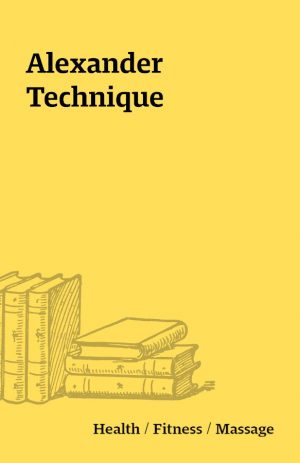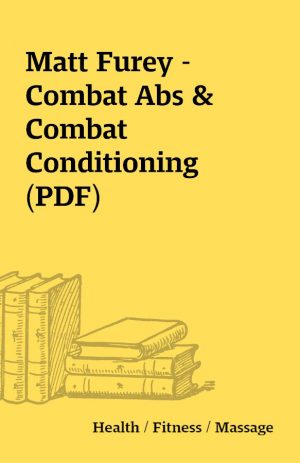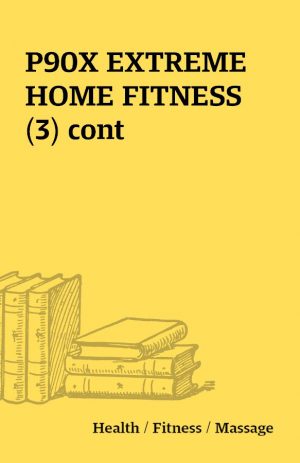Driskell and Wolinsky – Nutritional Concerns in Recreation, Exercise and Sport
Nutritional_Concerns_in_Recreation_Exercise_and_Sport.pdf
[1 eBook – PDF]
Description
Nutritional Concerns in Recreation, Exercise and Sport edited by Dr. Judy A. Driskell and Dr. Ira Wolinsky, 2009″… Drs. Driskell and Wolinsky have done an exceptionally good job in assembling information that provides a broad-based overview and detailed discussion of current topics related to physical activity and nutrition. … assembled a group of highly qualified experts from a wide variety of related fields… very user-friendly. … If one has questions about the latest findings regarding ‘hot topic” issues related to athletic training and competition (i.e. ergogenic supplements, effect of certain nutrients on athletic performance, changes in nutrition requirements in the life cycle, etc) the answers are easy to locate in this book. I recommend this book highly for anyone who is interested in a well-presented update on the relationship between diet and athletic performance….”—George Liepa, Ph.D., Eastern Michigan University, Ypsilanti, USA”Nutritional Concerns in Recreation, Exercise, and Sport has an all-star line-up of sports nutrition scientists who have contributed to the book. Edited by Judy A. Driskell and Ira Wolinsky, this book covers a range of topics such as hydration, vitamins, weight management and ergogenic aids. This book is a great resource for both the basic scientist as well as the fitness practitioner.”—Jose Antonio, Ph.D., CEO of the International Society of Sports Nutrition”Nutritional Concerns in Recreation, Exercise and Sport is a well-referenced text book suitable for the college classroom and exercise enthusiast. It contains current information regarding ergogenic aids and other topics in exercise and nutrition. A must read for the informed individual.”—Brian C. Leutholtz, Ph.D., FACSM, Baylor University, Waco, TexasContents1 Energy Requirements I. Introduction ……………………………………………………………………………… 2 II. Energy Balance and Its Components …………………………………………………… 2 A. What Is Energy? ……………………………………………………………………….. 2 B. Energy Intake ……………………………………………………………………………… 3 C. Energy Expenditure …………………………………………………………………….. 3 III. How to Assess Intake and Expenditure in Athletes ………………………………… 4 IV. Challenges of Matching Supply with Demand ……………………………………….. 5 A. Matching ATP Production with ATP Requirements ………………………… 5 B. Exercise Intensity and Duration …………………………………………………….. 6 C. Multiple Bouts of Exercise ……………………………………………………………. 7 D. Quantity vs. Quality of Energy Requirements …………………………………. 8 E. Long-Term Mismatch of Energy Supply and Demand ……………………… 8 1. Excessive Intake Relative to Demand (Energy Surplus) ……………… 8 2. Insufficient Intake Relative to Demand (Energy Deficit) …………….. 8 V. Energy Deficit for Weight Loss ……………………………………………………………. 9 VI. Does It Matter When You Consume Your Energy? ………………………………. 10 A. Acutely (Day of Competition or during Competition) …………………….. 10 B. Chronically……………………………………………………………………………….. 11 VII. Range of Intakes in Various Sport Situations ……………………………………….. 11VIII. Energy Efficiency …………………………………………………………………………….. 13 A. Do Athletes Become More Energetically Efficient? ……………………….. 13 B. Is There a Conservation of Energy? ……………………………………………… 13 IX. Environmental Factors and Special Populations …………………………………… 14 A. Altitude…………………………………………………………………………………….. 14 B. Climate …………………………………………………………………………………….. 14 C. Masters Athlete …………………………………………………………………………. 14 D. Diabetic Athlete ………………………………………………………………………… 15 E. Sex Differences …………………………………………………………………………. 15 IX. Future Research Needs ……………………………………………………………………… 16 X. Conclusions ……………………………………………………………………………………… 16References …………………………………………………………………………………….. 172 Carbohydrates and Fats I. Introduction ……………………………………………………………………………………..24 II. Carbohydrates …………………………………………………………………………………..24 A. Classifications and Dietary Sources………………………………………………24 B. Digestion and Absorption ……………………………………………………………28 C. Carbohydrate metabolism …………………………………………………………… 29 1. General metabolic Processes of Carbohydrate metabolism ………. 30 2. Carbohydrate metabolism during Exercise……………………………… 32 D. Carbohydrates and Exercise Performance ……………………………………..34 1. Temporal Issues ……………………………………………………………………34 2. Carbohydrate Loading………………………………………………………….. 36 3. Food Forms ………………………………………………………………………… 37 4. Types …………………………………………………………………………………. 41 5. Carbohydrate-Related Supplements ……………………………………….. 43 III. Fat …………………………………………………………………………………………………..46 A. Classifications and Dietary Sources……………………………………………… 47 1. TGs ……………………………………………………………………………………. 47 2. Fatty Acids …………………………………………………………………………. 47 3. Phosphoplipids ……………………………………………………………………. 50 4. Cholesterol………………………………………………………………………….. 50 B. Digestion and Absorption …………………………………………………………… 50 C. Lipid metabolism ………………………………………………………………………. 51 1. General metabolic Processes of Lipid metabolism ………………….. 51 2. Lipid metabolism during Exercise …………………………………………. 54 D. Lipids and Exercise Performance ………………………………………………… 55 1. Fat Loading ………………………………………………………………………… 55 2. MCT Oil …………………………………………………………………………….. 56 3. Conjugated Linoleic Acid ……………………………………………………… 57 4. Omega-3 Fatty Acids ……………………………………………………………. 58 5. Carnitine and Choline ………………………………………………………….. 59 E. Influence of Exercise on Lipid Status ……………………………………………60 IV. Conclusions ………………………………………………………………………………. 61References …………………………………………………………………………………. 623 Proteins I. Introduction …………………………………………………………………………………….. 75 II. Historical Perspective ……………………………………………………………………….. 76 III. Controversy ……………………………………………………………………………………… 76 IV. Critical Factors for Protein metabolism ………………………………………………. 77 A. Background ………………………………………………………………………………. 77 B. Nutrient Ingestion Timing …………………………………………………………… 77 1. Following Exercise ………………………………………………………………. 77 2. Before Exercise ……………………………………………………………………80 C. Protein Type ……………………………………………………………………………… 83 V. Research Needs………………………………………………………………………………… 85 VI. Conclusions ……………………………………………………………………………………… 85References …………………………………………………………………………………………………. 864 Vitamins I. Introduction …………………………………………………………………………………….. 91 II. Fat-Soluble Vitamins …………………………………………………………………………94 A. Vitamin A………………………………………………………………………………….94 B. Vitamin D………………………………………………………………………………….96 C. Vitamin E ………………………………………………………………………………….97 D. Vitamin K………………………………………………………………………………….99 III. Water-Soluble Vitamins …………………………………………………………………… 100 A. Thiamin ………………………………………………………………………………….. 100 B. Riboflavin ……………………………………………………………………………….. 101 C. Niacin …………………………………………………………………………………….. 102 D. Vitamin B6………………………………………………………………………………. 104 E. Folate ……………………………………………………………………………………… 105 F. Vitamin B12……………………………………………………………………………… 107 G. Pantothenic Acid ……………………………………………………………………… 109 H. Biotin ……………………………………………………………………………………… 109 I. Choline …………………………………………………………………………………… 110 J. Vitamin C ……………………………………………………………………………….. 111 IV. Conclusions and Future Research Needs……………………………………………. 114References …………………………………………………………………………………….. 1145 Minerals–Calcium, Magnesium, Chromium, and Boron I. Introduction …………………………………………………………………………………… 124 II. Dietary Reference Intakes ……………………………………………………………….. 124 III. Importance of Obtaining Accurate Dietary Intake Information ……………. 124 IV. Calcium …………………………………………………………………………………………. 125 A. Role of Calcium in the Human Body ………………………………………….. 125 B. Calcium Homeostasis ……………………………………………………………….. 125 C. Calcium Requirements ……………………………………………………………… 127 D. Calcium Status of Athletes………………………………………………………… 128 E. Calcium Supplementation and Exercise Performance …………………… 128 F. Calcium Supplementation and Intake on Weight Loss ………………….. 129 V. Magnesium ……………………………………………………………………………………. 129 A. Role of Magnesium in the Human Body……………………………………… 129 B. Measures of Magnesium Status …………………………………………………. 130 C. Magnesium Requirements…………………………………………………………. 130 D. Magnesium Status of Athletes …………………………………………………… 130 E. Magnesium Supplementation and Exercise Performance ………………. 132 VI. Chromium ……………………………………………………………………………………… 133 A. Role of Chromium in the Human Body and Chromium Requirements ………………………………………………………………………….. 133 B. Brief History of Chromium Supplementation ………………………………. 133 C. Chromium Supplementation and Exercise Performance ……………….. 133 VII. Boron ……………………………………………………………………………………………. 135 A. Boron Requirements and Boron Supplementation and Exercise Performance ……………………………………………………………………………. 135VIII. Limitations of Previous Research ……………………………………………………… 137 IX. Future Research Needs ……………………………………………………………………. 137 X. Conclusions ……………………………………………………………………………………. 138References ……………………………………………………………………………………………….. 1386 Hydration I. Introduction …………………………………………………………………………………… 145 II. Topical Overview of Water ………………………………………………………………. 146 III. Properties of Water …………………………………………………………………………. 146 IV. Definition and Symptoms of Dehydration ………………………………………….. 147 V. Regulation of Thirst and Hydration …………………………………………………… 148 VI. Hydration and Health and Disease ……………………………………………………. 150 VII. Hydration and Physical and Athletic Performance………………………………. 152VIII. Practical Measurements of Hydration ……………………………………………….. 154 IX. The Difference between Water and Other Means of Rehydration …………. 156 X. Fluid Replacement ………………………………………………………………………….. 159 XI. Conclusions ……………………………………………………………………………………. 160References …………………………………………………………………………………….. 1617 Weight Management I. Introduction …………………………………………………………………………………… 168 II. Weight Management Concepts …………………………………………………………. 168 A. Energy Balance ……………………………………………………………………….. 168 1. Energy Intake and Expenditure……………………………………………. 168 2. Diet-Induced Thermogenesis ………………………………………………. 170 B. Weight Loss …………………………………………………………………………….. 172 C. Weight Gain ……………………………………………………………………………. 172 D. Weight Maintenance ………………………………………………………………… 173III. Dietary Macronutrient Composition………………………………………………….. 173 A. High Carbohydrate Diets ………………………………………………………….. 173 1. Glycemic Index of Carbohydrates ………………………………………… 173 B. High Protein Diets……………………………………………………………………. 175 C. Diet Foods ………………………………………………………………………………. 177IV. Weight Management Supplements…………………………………………………….. 177 A. Fat Blockers …………………………………………………………………………….. 177 1. Fiber…………………………………………………………………………………. 177 2. Gymnema sylvestre ……………………………………………………………. 178 3. Chitosan……………………………………………………………………………. 178 B. Thermogenics ………………………………………………………………………….. 178 C. Lypolytic Nutrients ………………………………………………………………….. 179 1. Betaine……………………………………………………………………………… 179 2. Calcium Pyruvate ………………………………………………………………. 179 3. Carnitine …………………………………………………………………………… 181 4. Chromium ………………………………………………………………………… 181 5. Forskolin (Coleus forskholii)……………………………………………….. 182 6. Conjugated Linoleic Acids (CLA) ………………………………………… 182 7. Dehydroepiandrosterone (DHEA) and 7-Keto DHEA …………….. 183 8. Garcinia cambogia (HCA)………………………………………………….. 183 9. Phosphatidyl Choline (Lecithin) ………………………………………….. 184 D. Psychotropic Herbs…………………………………………………………………… 184 1. Hoodia gordonii ………………………………………………………………… 184 E. Diuretics …………………………………………………………………………………. 184 F. Weight Gain and Muscle Mass ………………………………………………….. 185 1. Protein ……………………………………………………………………………… 186 2. Creatine ……………………………………………………………………………. 186 3. b-hydroxy b-methylbutyrate (b-HMB) …………………………………. 187 4. Beta-Alanine …………………………………………………………………….. 188 V. Future Research Needs ……………………………………………………………………. 188 VI. Conclusions ……………………………………………………………………………………. 189References ……………………………………………………………………………………. 1908 Endurance Performance I. Introduction …………………………………………………………………………………… 201 II. Exercise metabolism ……………………………………………………………………….202 III. Energy Expenditure and Intake …………………………………………………………202 IV. Macronutrients ………………………………………………………………………………..204 A. Carbohydrate ……………………………………………………………………………204 B. Protein …………………………………………………………………………………….207 C. Fat …………………………………………………………………………………………..208 V. Micronutrients ………………………………………………………………………………..209 VI. Water and Sodium ………………………………………………………………………….. 211 VII. Fueling and Fluid Replacement ………………………………………………………… 214 A. Carbohydrate Loading for Competition ………………………………………. 214 B. Pre-Exercise Meal and Hydration ………………………………………………. 215 C. Glycerol Hyperhydration …………………………………………………………… 216 D. Exercise Fueling and Hydration …………………………………………………. 217 E. Recovery Nutrition and Hydration ……………………………………………… 222VIII. Strategies to Enhance Fat Oxidation ………………………………………………….224 A. Caffeine …………………………………………………………………………………..224 B. Short-Term Fat Adaptation ………………………………………………………… 225 IX. Ultra-Endurance and Multi-Day Events …………………………………………….. 225 X. Future Research Needs ……………………………………………………………………. 226 XI. Conclusions ……………………………………………………………………………………. 227References …………………………………………………………………………………….. 2289 Purported Ergogenic AidsI. Introduction …………………………………………………………………………………….. 236II. Ergogenic Aids and Human Use…………………………………………………………. 236 A. Strong Human Research to Support Use ……………………………………… 236 1. b-Alanine …………………………………………………………………………. 236 2. b-Hydroxy-b-Methylbutyrate (HMB) …………………………………… 239 3. Caffeine …………………………………………………………………………….240 4. Creatine ……………………………………………………………………………. 241 5. Essential Amino Acids (EAAs) …………………………………………… 242 6. Sodium Bicarbonate ……………………………………………………………244 7. Sodium Citrate……………………………………………………………………244 B. Equivocal Human Research to Support Use …………………………………. 245 1. Alpha-Ketoglutarate (AKG) ………………………………………………… 245 2. Alpha-Ketoisocaproate (KIC) ……………………………………………… 245 3. Alpha-Lipoic Acid (ALA) ……………………………………………………246 4. Branched-Chain Amino Acids (BCAAs)……………………………….246 5. Colostrum …………………………………………………………………………. 247 6. Dehydroepiandrosterone (DHEA)…………………………………………248 7. Gamma-Aminobutyric Acid (GABA) …………………………………… 249 8. Ginseng…………………………………………………………………………….. 249 9. Glycerol ……………………………………………………………………………. 250 10. N-Acetylcysteine (NAC) …………………………………………………….. 250 11. Rhodiola …………………………………………………………………………… 251 12. Ribose ………………………………………………………………………………. 252 13. Taurine……………………………………………………………………………… 252 C. Limited to No Human Research to Support Use …………………………… 253 1. Adenosine Triphosphate (ATP) ……………………………………………. 253 2. Betaine……………………………………………………………………………… 253 3. Choline …………………………………………………………………………….. 254 4. Chromium ………………………………………………………………………… 254 5. Citrulline Malate ……………………………………………………………….. 254 6. Conjugated Linoleic Acid (CLA) …………………………………………. 255 7. D-Pinitol …………………………………………………………………………… 255 8. Ecdysterone ………………………………………………………………………. 256 9. Glutamine …………………………………………………………………………. 256 10. Hydroxycitric Acid (HCA) ………………………………………………….. 257 11. Octacosanol ………………………………………………………………………. 257 12. Pyruvate……………………………………………………………………………. 258 13. Tribulus…………………………………………………………………………….. 258 14. Tyrosine ……………………………………………………………………………. 258 15. Yohimbine ………………………………………………………………………… 259III. Summary and Conclusions …………………………………………………………………260References …………………………………………………………………………………………26610 Life Cycle Concerns I. Introduction …………………………………………………………………………………… 282 II. Child and Adolescent Athletes …………………………………………………………. 282 A. Introduction …………………………………………………………………………….. 282 B. Factors Affecting Nutritional Needs …………………………………………… 283 C. Energy Requirements ………………………………………………………………..284 D. Macronutrients ………………………………………………………………………… 285 1. Carbohydrates……………………………………………………………………. 285 2. Fat ……………………………………………………………………………………. 286 3. Protein ……………………………………………………………………………… 287 E. Micronutrients …………………………………………………………………………. 288 1. Vitamins …………………………………………………………………………… 288 2. Minerals …………………………………………………………………………… 289 F. Fluids ……………………………………………………………………………………… 291 G. Supplement Use ……………………………………………………………………….. 293 H. Food Habits …………………………………………………………………………….. 295 I. Adolescent Body Image and Weight Control ……………………………….. 298 J. Disordered Eating ……………………………………………………………………. 299 K. Summary …………………………………………………………………………………300III. Pregnant and Lactating Athletes ………………………………………………………. 301 A. Introduction …………………………………………………………………………….. 301 B. Energy Requirements ………………………………………………………………..302 C. Carbohydrate Requirements………………………………………………………. 303 D. Protein Requirements ……………………………………………………………….. 303 E. Iron Requirements……………………………………………………………………. 303 F. Folic Acid Requirements……………………………………………………………304 G. Other Considerations…………………………………………………………………304 1. Thermoregulation ……………………………………………………………….304 2. Caffeine …………………………………………………………………………….304 3. Adolescent Athletes and Pregnancy ………………………………………304 4. Postpartum ……………………………………………………………………….. 305 H. Recommendations ……………………………………………………………………. 305IV. The Aging Athlete …………………………………………………………………………..306 A. Introduction ……………………………………………………………………………..306 B. Factors Affecting Nutritional Needs ……………………………………………307 C. Energy Requirements ………………………………………………………………..307 D. Macronutrients …………………………………………………………………………309 1. Carbohydrates……………………………………………………………………. 310 2. Fat ……………………………………………………………………………………. 310 3. Protein ……………………………………………………………………………… 311 E. Micronutrients …………………………………………………………………………. 312 1. Vitamins …………………………………………………………………………… 314 2. Minerals …………………………………………………………………………… 319 F. Fluids ……………………………………………………………………………………… 321 G. Supplement Use ……………………………………………………………………….. 322 H. MedicationNutrient Interactions ………………………………………………. 324 I. Summary ………………………………………………………………………………… 325 V. Conclusions ……………………………………………………………………………………. 325 VI. Future Research ……………………………………………………………………………… 326References ……………………………………………………………………………………… 326Index
You must be logged in to post a review.






Reviews
There are no reviews yet.